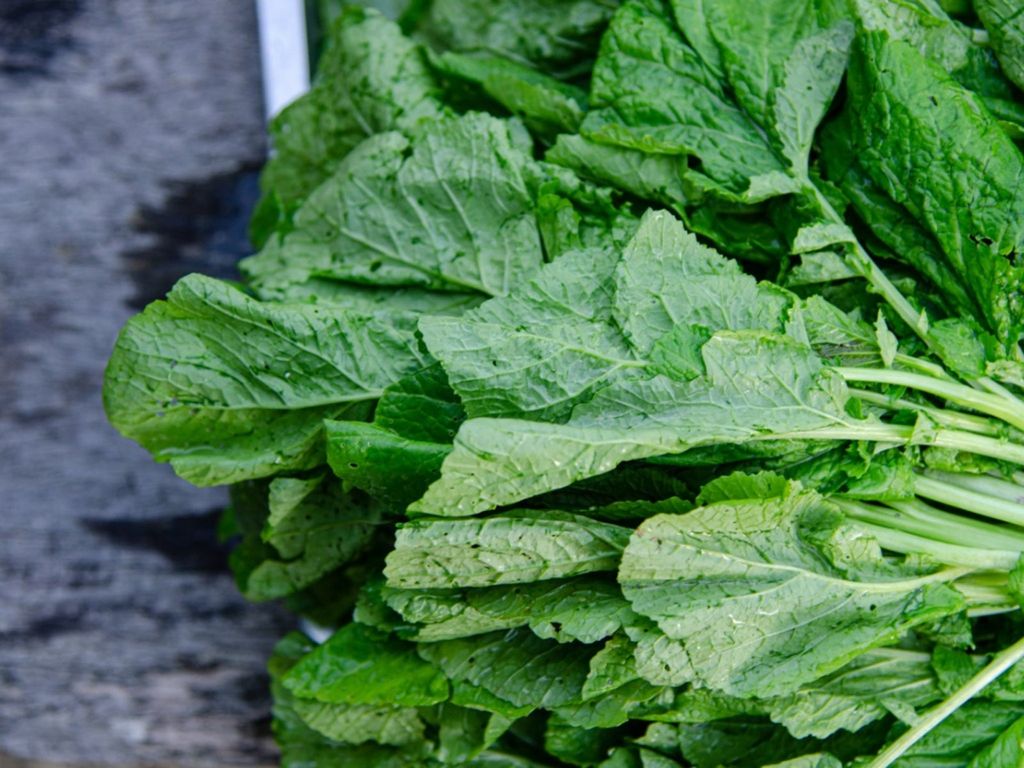The mustard plant is most well known for its tiny, yellowish seeds that produce one of the most popular condiments on Earth, mustard. But for centuries, a range of cultures have used the plantâs green leaves for food and health purposes, such as a/an:
Modern research supports mustard greensâ rich nutritional contentâtheyâve got more vitamin A than spinach and more vitamin C than oranges. While studies donât acknowledge all of its traditional uses, they suggest the greens can bring a number of health benefits.
Today, there are many different varieties of mustard greens available that add a bitter, spicy flavor to any meal. You can eat them raw, boiled, steamed, or stir-fried. Itâs easy to add mustard greens to your diet.Â
Mustard greens are a rich source of vitamins and minerals your body needs to stay healthy. One serving contains almost half of your daily vitamin C needs. Vitamin C contributes to your bodyâs immune system defenses, so itâs important to get enough of it throughout your day.
Cooked mustard greens can also have up to your entire daily requirement of vitamin A. This vitamin supports many body functions, including good heart, lung, and kidney health. Â
Mustard greens contain a range of powerful phytonutrients. These plant-based antioxidants protect your cells from stress and damage caused by the free radicals our bodies accumulate from aging, the environment, and lifestyle behaviors.
Like other cruciferous vegetables, mustard greens also contain glucosinolates, nutrients that give the plant a bitter flavor. In addition to their antioxidant activity, studies show glucosinolates may fight cancer cells and prevent tumor formation, but more research is needed to study these effects.Â
Studies show that a daily intake of green leafy vegetables like mustard greens significantly reduces your heart disease risk. They also contain nutrients that help lower cholesterol levelsâan effect thatâs especially strong when you cook the greensâkeeping your arteries clear from buildup that leads to heart problems and stroke.Â
A serving of mustard greens also packs an entire daysâ worth of vitamin K. This nutrient helps your body clot blood and your heart function.
In addition to its role in heart health, vitamin K helps keep your bones healthy. Vitamin K deficiencies can lead to a higher risk of bone mineral abnormalities and osteoporosis.
Studies show that getting enough vitamin K in your diet could improve bone strength and protect against fractures. It also helps prevent problems associated with osteoporosis, like blocking the buildup of calcium in the arteries, causing them to harden.
Among its antioxidant profile, mustard greens contain lutein and zeaxanthin. Research shows that these two nutrients are essential for maintaining healthy eyes and may prevent age-related vision loss.
While research is ongoing, studies suggest that lutein may also benefit brain tissue. This effect may support better cognitive performance and reduced risk of mental decline.
Mustard greens contain many health-boosting antioxidants like beta carotene, which can protect your skin and lower risk factors of diabetes. The greens are also a great source of several B vitamins, including thiamine (B1,) niacin (B3,) and pyridoxine (B6.)Â
According to the American Heart Association, one portion of leafy greens like mustard greens is one cup when raw and one-half cup when cooked.
The USDA recommends you get at least 18 to 21 cups of vegetables per week in your diet. Of this total, at least 1.5 to 2 cups should come from dark green vegetables like mustard greens.Â
Because mustard greens contain high levels of vitamin K, people taking blood thinners should talk to their doctor about adding them to their diet so that your portions donât interact with the medication.
Leafy greens are also high in oxalates, which could increase the risk of kidney stones in people with kidney disease.
Both the leaves and stalks of mustard greens can be eaten. But both will become tough and more pungent tasting as the weather warms. The best mustard leaves for eating raw or for cooking are harvested young and tender.

More on Diet & Weight Management


How to Prepare Mustard Greens
You can find different mustard greens at the grocery store, including red, purple, and many green varieties.Â
In the United States, the three most popular mustard plants are:
- Curly-leafed mustard greens that resemble kale and have a spicy but subtle flavor
- Flat-leafed mustard greens ranging from mild to zesty tastes
- Mustard spinach that has a smooth, bitter taste like spinach
You can eat mustard greens raw or cooked, but how you prepare them may alter the vegetableâs nutritional content. Cooked mustard greens have higher levels of vitamin K, vitamin A, and copper, but the amount of vitamin C and E is reduced.
Add these leafy greens to your diet by:
- Mixing mustard greens into a chopped salad
- Blending them into a smoothie
- Adding them to soups and stews
- Stir-frying the greens with a healthy fat and an acid like lemon juice to balance the taste
- Roast mustard greens seasoned with garlic and spices as a side dish
- Pickling the greens with sugar, vinegar, and salt
Mustard Greens 101 – Nutrition and Health Benefits
FAQ
What part of mustard greens is edible?
Do you take the stems off mustard greens?
